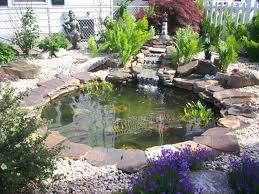





In design terms, the semi-formal water garden is neither one thing nor another. However, in small gardens, where it is not always easy to create a completely formal or informal scheme, it can play an invaluable role. It can often link different areas of the garden, the pool itself providing a focal point. One part of the garden may be of formal design, the approach to the pool being of a strictly regimented nature, while on the other side, the planting may be more liberal and informal.
 In an ordinary domestic setting, the semi-formal pool can be most appealing, having a comfortable lived-in air that is denied those who have water gardens on a grand scale. Not unlike the family home compared to the stately property, it may not be as perfect technically or artistically, but it will be much loved, well used and very functional.
In an ordinary domestic setting, the semi-formal pool can be most appealing, having a comfortable lived-in air that is denied those who have water gardens on a grand scale. Not unlike the family home compared to the stately property, it may not be as perfect technically or artistically, but it will be much loved, well used and very functional.
On such a modest scale, where most functions of a water feature are desired, the semi-formal pool offers the greatest versatility. Whether you want to introduce a fountain or waterfall, a collection of aquatic plants or fish, or simply some amusing ornament, each can be integrated successfully and arranged in a semi-formal setting without offending the eye unduly.
The semi-formal pool is often the best option for the family, for it can embrace aspects that satisfy all ages and interests. It can become the focus of outdoor activity, providing an interesting feature to sit around and perhaps eat and drink, or simply enjoy the antics of the fish.
The configuration that a semi-formal water garden takes will be restricted only by your imagination. For example, one side of the pool may be formed by a border, path or patio, and the other by a lawn or groundcover. The edge of the pool does not have to be uniform throughout, and materials as diverse as timber decking and paving can he incorporated in the same feature.
Planting can be used to remove the harshness of the edge where desired, although a straight clean line can also prove attractive, and peripheral planting can be set back in spaces created by removing the occasional paving slab. The opportunities for innovation are innumerable.
While it is generally agreed that a pool should be level, the surrounding ground does not have to match. Sometimes, the differing levels of a garden are major attractions, and the pool must be fitted into undulating terrain. This is often easier if a semi-formal shape is adopted, for part of the pool can be raised while the rest is set into the ground.
A partially raised pool can also link with raised and partially raised beds or borders. There is no reason why water cannot be simply one of a series of interconnected planting features; provided the structure is level overall, water can be fully integrated into a series of planted designs. This is not only appropriate where the land slopes and options are limited, but is also useful for the less able, who can enjoy the water feature at a more convenient height.
However, a semi-formal water garden does not have to be raised to be linked to other features, for planting designs can be equally successful on the flat. More often, under such circumstances, the water forms a thread that runs through a planted area: an angular channel or shape within an informal grouping of plants or, conversely, an irregular configuration among a more formal and rigid planting scheme. Each can affect the other, either reducing stiffness and rigidity or sharpening liberal informality.
A semi-formal water garden relies on surrounding plants rather more than either a formal or informal design. With these, the water feature can be self contained, a formal pool utilizing the open water and strategic planting, while the informal pool is of tangled informality. In a semi-formal setting, there are no rules. The reflections of surrounding plants and their relationship with the waterside planting, together with the reflective nature of the pool, must he taken into account from the outset. The result will be very personal, echoing the taste of the individual.
However, if the pool is to stand alone, it can become very confused, for the temptation is to utilize the freedom of expression that a semi-formal feature offers and to create what amounts to a compendium of water gardening, incorporating all that is good in a single feature. To reduce some of the fussiness that can arise in this situation, and provide greater planting opportunities, it is useful to extend the water feature into a bog garden.
When planning a semi-formal water garden, consider it from every point of view: the practical and the aesthetic, as well as the pleasurable. Ensure maximum enjoyment by installing outdoor lighting, which will transform a modest pool and patio into an evening wonderland. Design the planting around the pool to accommodate the lights so that they are not intrusive during daylight, and arrange any fountain or waterfall so that it can be accentuated by the lights.
A semi-formal pool is one of the most exciting types of water feature, but also one of the most challenging. However, because it does not have to conform to particular design ethics or planting criteria, it is unquestionably the most variable and interesting. The only rules that you need to follow are those pertaining to the plants and fish in the context of a balanced environment. Otherwise, do your own thing.
Copyright © www.100flowers.win Botanic Garden All Rights Reserved